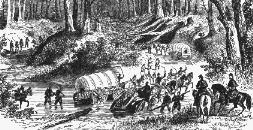The Red River Campaign
 |  |  |
Gen. Frederick Steele | Gen. Kirby Smith |
The Red River Campaign
 |  |  |
Gen. Frederick Steele | Gen. Kirby Smith |
In the first few months of the civil war, the north discovered that it was faced with a serious cotton shortage. No longer could cotton be purchased from the southern states and hungry textile mills of the north needed cotton in order to produce. Union politicians, civilian interest groups, and the military decided that if the state of Texas could be occupied by union forces, they could grow cotton to supply the empty mills in the north. A Plan was drawn up.
Major Gen. Nathaniel P. Banks was to sail from New York, enter the Red River in Louisiana and join a union force marching south from Little Rock. Together the two columns would invade Texas and secure the area for the north. The plan was to be called the Red River Expedition. It was not until 1864, however , that the plan was put into effect.
In September of 1863, Major Gen. Frederick Steele, with 20,000 men advanced from Helena and captured Little Rock. The Arkansas state government fled to the southwestern part of the state, settling in the Hempstead County courthouse at Washington, Arkansas. On March 23, 1864, General Steele left Little Rock to join General Banks in the Red River region of Louisiana, and begin the invasion of Texas.
Steele followed a route which roughly parallels today's Interstate 30. His union forces crossed the Ouachita River at Rockport (near where the Ouachita crosses the Interstate at Malvern) and continued southwest toward Texas. Steele's army first encountered heavy resistance at the crossing of the Little Missouri River where the bloody affair took place between Steele's leading division and 3,000 Confederate dismounted cavalry. Further south on Prairie De Ann, near Prescott, the entire Confederate force dug in. A day and a half of hard fighting was needed to dislodge the outnumbered rebels.
The fighting at Prairie De Ann slowed Steele, and spring rains had begun. The dirt roads turned into a quagmire. After two weeks of marching, Steele had covered only 70 miles, and Confederate resistance was strengthening, particularly around Washington, the Confederate state capital. General Steele decided to alter his plans and turn east toward Camden instead of proceeding directly to Shreveport.
His army camped at White Oak Creek, 18 miles west of Camden on the night of the 12th; then after a 2 hour skirmish, marched toward Camden. The Federals entered the city with little difficulty on April 13, 1864.
Return to the Enlisted Man's Web Site